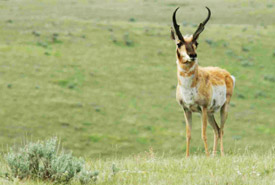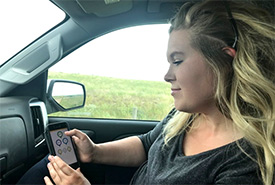Tracy Lee-Miistakis, Senior Project Manager

Pronghorn antelope, Old Man on His Back (Photo by Karol Dabbs)
Pronghorn Xing
What is the problem you are looking to solve or the question you are looking to answer?
Pronghorn undertake seasonal and long-distance movements to meet life requirements. Highways fragment the landscape and cause direct mortality and/or disruption to movement patterns. Pronghorn are an important species economically, and currently there is a higher demand for hunting than can be supplied.
Can you give us a general description of the project?
Pronghorn Xing is a citizen science program developed to ground-truth modeling of animal migration pinch points identified across highways in Alberta and Saskatchewan that are key for movement and connectivity on the prairie landscape. Another aspect of the program is to increase public engagement in pronghorn science and conservation.
What will you learn from your project?
We will learn where pronghorn move across the highway, and if these areas align with connectivity modelling and areas of high vehicle collisions.
What is the biggest achievement of the project to date?
Pronghorn Xing has successfully engaged over 200 participants in data collection. Preliminary analysis shows good alignment with connectivity modelling and provides information important for prioritizing road sections for mitigation.
How can this project benefit NCC’s work and other conservation initiatives?
This work will benefit NCC by identifying areas along Highway 1 where private land conversation initiatives would benefit pronghorn conservation.
What is your favourite part of the project you are working on?

Megan Jensen using Pronghorn Xing app (Photo courtesy Tracy Lee)
Anybody can join in and contribute to reporting where they see pronghorn crossing Highway 1. This enables people who care about wildlife to contribute meaningfully to pronghorn conservation.
What gets you excited about the species/habitat your project is investigating?
Conservation research is helping us understand how to keep pronghorn moving around the landscape. We need to ensure they can get under fences by raising the lowest wire on fences and removing the barrier effect of high-volume roads. There are solutions; we just need to prioritize implementation.
What is the impact you are hoping to achieve in Alberta (or beyond) with the project you are involved with?
The Pronghorn Xing program can serve as a model for working with provincial agencies, the public and conservation groups to advance the conservation of pronghorn by reducing the barrier effect of roads.
Is there a place people that are interested in your project can go to learn more?
Learn more about this project here.
Fun fact
Pronghorn are North America's fastest land animal, clocking out at 98 kilometres per hour!





